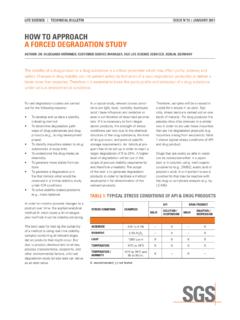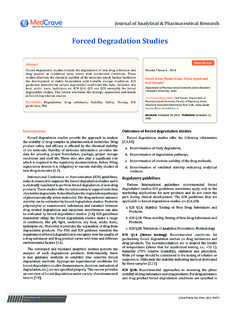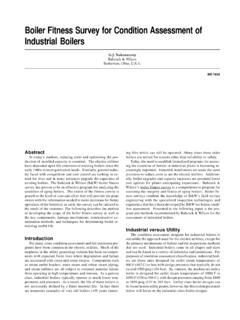Transcription of ON-FARM COMPOSTING METHODS
1 ON-FARM COMPOSTING Methods1ON- farm COMPOSTING Misra and R. N. RoyFAO, RomeOn- farm COMPOSTING Methods2 CONTENTSE xecutive METHODSA naerobic The Indian Bangalore Passive COMPOSTING of Manure PilesAerobic decomposition through Passive The Indian Indore Pit Heap Chinese Rural The pit High temperature compostLarge Scale Passive Windrow Turned Passively aerated COMPOSTING METHODSS hredding and Frequent The Berkley Rapid COMPOSTING MethodUse of Mineral Nitrogen North Dakota State University Hot COMPOSTING Use of Effective Micro-organisms (EM) EM based Quick Compost Production ProcessOn- farm COMPOSTING Methods3 Use of Cellulolytic IBS Rapid COMPOSTING IBS Rapid IBS Rapid Commercial Rapid Rice Straw CompostingUse of Forced Aerated Static PileControlled Systems with Forced Aeration and Accelerated Mechanical In-Vessel Bin Rectangular Agitated Rotating Transportable ContainersUse of Vermicomposting in Vermicomposting in Worm troughs in a Windrows Vermiculture in IndiaOn- farm COMPOSTING Methods4 EXECUTIVE SUMMARYOn- farm COMPOSTING methodsGrowing concerns relating to land degradation .
2 Threat to eco-systems from over andinappropriate use of inorganic fertilizers, atmospheric pollution, soil health, soil biodiversityand sanitation have rekindled the global interest in organic recycling practices likecomposting. The potential of COMPOSTING to turn ON-FARM waste materials into a farm resourcemakes it an attractive proposition. COMPOSTING offers several benefits such as enhanced soilfertility and soil health thereby increased agricultural productivity, improved soilbiodiversity, reduced ecological risks and a better though the practice is well known, farmers in many parts of the world especiallyin developing countries find themselves at a disadvantage by not making the best use oforganic recycling opportunities available to them, due to various constraints which amongothers include absence of efficient expeditious technology, long time span, intense labour,land and investment requirements.
3 And economic is an extensive literature on COMPOSTING methodology. However, thebackground paper presents only a selective and brief account of the salient approaches. Abroad distinction as Traditional and Rapid COMPOSTING practices has been made, basedmainly on the considerations of the practices being adopted as a convention; and the recentintroductions for expediting the process, involving individual or combined application oftreatments like shredding and frequent turning, mineral nitrogen compounds, effective micro-organisms, use of worms, cellulolytic organisms, forced aeration, forced aeration andmechanical turnings and so and large, Traditional METHODS adopt an approach of anaerobic decomposition,or aerobic decomposition based on passive aeration through measures like little andinfrequent turnings or static aeration provisions like perforated poles/pipes.
4 And are timetaking processes involving several months. On the other hand, Rapid METHODS make use ofthe treatments introduced recently such as those mentioned above to expedite the aerobicdecomposition process and bring down the COMPOSTING period around four to five weeks. Besides, there are certain other recently introduced approaches like Vermi- COMPOSTING , which though bring down the process duration to a good extent as compared tothe conventional METHODS besides producing a far-superior quality product, have a lower turn-over and longer time taken as compared to other Rapid METHODS .Traditional METHODS based on passive COMPOSTING approach involve simply stackingthe material in piles or pits to decompose over a long period with little agitation andmanagement.
5 Indian Bangalore method relying on this approach permits anaerobicdecomposition for a larger part of operations and requires six to eight months for theoperations to complete. The method is still in use in the urban areas of the developing world,mostly for treatment of urban wastes. A method similar in approach involving anaerobicdecomposition and followed in western globe with large farms, is the Passive COMPOSTING ofOn- farm COMPOSTING Methods5 Manure Piles . The active COMPOSTING period in this process may range from one to twoyears. Indian Indore method , which slightly enhances passive aeration through a fewturnings - thereby permitting aerobic decomposition; reduces the time requirement; andenables production in a time-span of around four months.
6 Chinese rural COMPOSTING METHODS ,based on passive aeration approach through turnings/ aeration holes, provide output in two tothree months. The METHODS are extensively used in developing world. Though the labourrequirements for these METHODS are high, they are not capital intensive and do not requiresophisticated infrastructure and machinery. Small farmers find them easy to practice,especially in those situations where manual labour is not a constraint. However, the lowturnover and longer time span are the major bottlenecks. Turned Windrows have been in use with the large farms especially in the developedparts of the world.
7 The windrows are periodically turned using a bucket loader or specialturning machine, commonly available on these farms. The turning operation mixes thecomposting materials, enhances passive aeration and provides conditions congenial foraerobic decomposition. COMPOSTING operations may take upto eight weeks. Passively AeratedWindrows eliminate the need for turning by providing air to the materials via pipes, whichserve as air ducts. Active COMPOSTING period could range between ten to twelve METHODS like Berkley Rapid COMPOSTING and North Dakota State UniversityHot COMPOSTING involve accelerated aerobic decomposition through measures like choppingof raw materials to small size; use of mineral compounds like ammonium sulphate, chickenmanure, urine; and turning of the material on daily basis.
8 While chopping without muchmachinery support may be possible at smaller scales, mechanisation may be necessary at largescale applications. Whereas Berkley Rapid COMPOSTING METHODS claims an activecomposting period of two to three weeks only, North Dakota State University HotComposting may take four to six weeks. EM based Quick Compost Process involves aerobic decomposition of rice husk/branand cow dung as raw materials in pits as enabled through turnings; and uses effective micro-organisms as activator for expediting the decomposition process. The use of EM as activatorbrings down the COMPOSTING period requirement from twelve weeks to four example of cellulolytic culture based method is the IBS Rapid COMPOSTING whichis a development of windrow type of COMPOSTING .
9 Salient process features include choppingof vegetative organic materials, passive aeration provisions through air ducts and use ofcellulose decomposer fungus (Trichoderma harzianum).The process requires about forced aeration based METHODS like Aerated Static Pile reduce thecomposting time period further, allow for higher, broader piles and have lower landrequirements as well in comparison to Windrow or Passively Aerated Windrow , there is little experience using Aerated Static Piles with agricultural is commonly used for treatment of municipal sewage sludges. Active compostingperiod may range between three to five forced aeration and acclerated mechanical turning METHODS like In-vesselcomposting are specially designed commercial systems, with potential advantages likeOn- farm COMPOSTING Methods6reduced labour, weather proofing, effective process control, faster COMPOSTING , reduced landrequirement, and quality output.
10 However, high investment and recurring costs related tooperation and maintenance could be a bottleneck for adoption especially in economicallybackward areas. Among the systems, Bins and Rectangular Agitated Beds , in particular,have found place on several large farms in developed world. Bin COMPOSTING involvesprovisions for forced aeration in the bin floor; little turning of the COMPOSTING material; andmovement of material from one bin to another. Agitated Bed Systems appear to havepromise for ON-FARM rapid COMPOSTING . However, the cost for the system is manufactured large systems (150 tons/day or larger) reportedly availablethough; small systems (20 tons/day or less) likely to interest the majority of farmers, arelacking.














